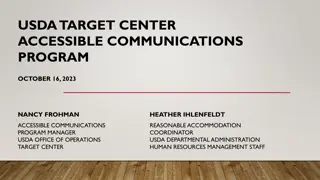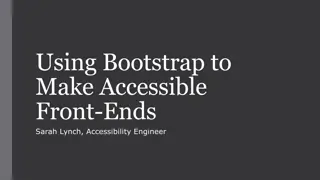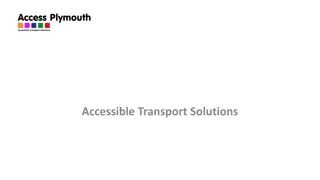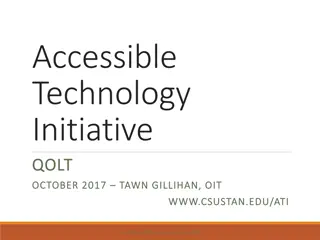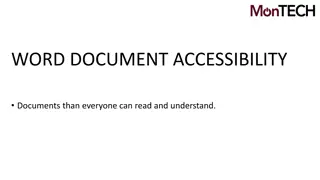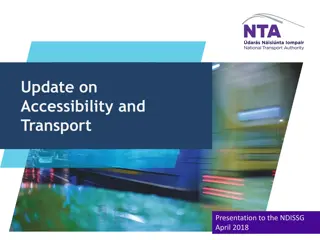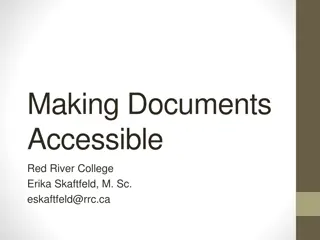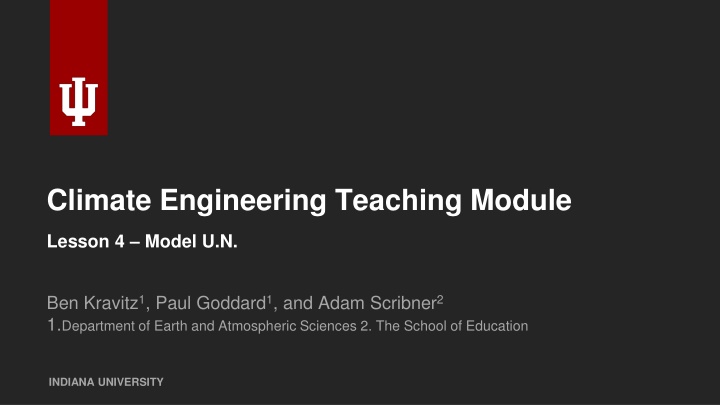
Model U.N. Climate Engineering Teaching Module Lesson 4
This teaching module focuses on a simulated United Nations meeting in 2030 to discuss the deployment of climate engineering technologies. Representatives from six nations negotiate whether to start a trial run of climate engineering due to worsening climate change effects. Students engage in pre-negotiation activities, analyze country information, and decide on deployment based on advantages and disadvantages for their country.
Uploaded on | 0 Views
Download Presentation

Please find below an Image/Link to download the presentation.
The content on the website is provided AS IS for your information and personal use only. It may not be sold, licensed, or shared on other websites without obtaining consent from the author. If you encounter any issues during the download, it is possible that the publisher has removed the file from their server.
You are allowed to download the files provided on this website for personal or commercial use, subject to the condition that they are used lawfully. All files are the property of their respective owners.
The content on the website is provided AS IS for your information and personal use only. It may not be sold, licensed, or shared on other websites without obtaining consent from the author.
E N D
Presentation Transcript
Climate Engineering Teaching Module Lesson 4 Model U.N. Ben Kravitz1, Paul Goddard1, and Adam Scribner2 1.Department of Earth and Atmospheric Sciences 2. The School of Education INDIANA UNIVERSITY
Objective Model a United Nations meeting on whether to deploy climate engineering technologies
Background Statement The year is 2030. Climate change has been getting steadily worse, and nations around the world are feeling its effects. The Secretary General of the United Nations has called a summit to discuss whether the world should start a trial run of climate engineering. Representatives from six nations (Angosia, Durhan, Florin, Tanoa, Molvania, and Guilder) have traveled to the U.N. to begin negotiations. If they agree that deployment should start, it will begin in 2035, which is around the time global average temperature will be 1.5 C (nearly 3 F) warmer than in the preindustrial era. INDIANA UNIVERSITY
Pre-Negotiations Preparation Worksheet One (1) 1. Each student circles two of the most important secret facts from their country s private information. 1. Then, compare with the rest of their group and agree together. INDIANA UNIVERSITY
Pre-Negotiations Preparation Worksheet One (2) 1. Using the public information, discuss within their groups which countries they view as potential allies or potential conflicts 1. Within their group, discuss what bargaining/negotiating chips they have to help develop treaties. Examples - resources, money, pledging support INDIANA UNIVERSITY
Pre-Negotiations Preparation Worksheet One (3) Based on your country's information (both public and classified) decide whether climate engineering should be deployed and why. Frame this in terms of advantages or disadvantages for your country. If information that you need is not stated, you are encouraged to be creative and come up with that information yourselves. You may also decide whether the public information about you that is provided to other countries is truthful. INDIANA UNIVERSITY
Pre-Negotiations Preparation Worksheet One (4) Establish Roles President (1): Stays at the group s table and manages the diplomats, writing treaties, and science advisors Diplomats (2-4): Engage in negotiations with delegates from other countries. This includes both diplomats that go to other tables, as well as one diplomat that stays at their table to receive other delegations. Treaty Writer (1): Works with the President to collect information from their Diplomats and Diplomats from other countries to create written treaties. Treaties must be signed by each countries President, treaty writer, and participating diplomats. Science Advisor (1): Works with the President and Diplomats to assert relevant climate science and climate engineering knowledge into the ongoing negotiations. INDIANA UNIVERSITY
Public Information (1) INDIANA UNIVERSITY
Public Information (2) Angosia Angosia is a rising world power, largely because they have used fossil fuels to rapidly expand energy production. They are suffering from the effects of climate change but have repeatedly stated that economic growth is their highest priority, and through economic growth they will become more resilient to environmental changes. Thus far, climate change has been rather mild in Angosia, so their policy has worked. Angosia has recently invested in infrastructure projects at home and in Durhan as a way of building up protections against climate change. Angosia has made no public statement on climate engineering, preferring to wait and see . INDIANA UNIVERSITY
Public Information (3) Durhan Durhan is one of the poorest countries in the world. They are suffering from climate change, and as a poor nation, there is not a lot they can do about it. All of the other rich nations got rich through use of fossil fuels, and Durhan believes it has the right to become wealthy quickly by doing the same. Durhan has great fossil fuel resources but doesn t have the infrastructure to mine them. Durhan believes that climate engineering is necessary to rapidly reduce the effects of climate change in their country, but they are distrustful of other rich nations deploying it, because those nations have a long history of exploiting Durhan. INDIANA UNIVERSITY
Public Information (4) Florin A long-time world power, Florin is one of the wealthiest nations in the world. It is also the heaviest user of fossil fuels in the world and thus is one of the most responsible for climate change. Although renewable energy has been on the rise in Florin, the nation s energy consumption is so great that it needs fossil fuels to maintain its citizens quality of life. Florin is publicly opposed to climate engineering because it will cause winners and losers among the nations of the world, and the poorest nations are already having a hard enough time with climate change. INDIANA UNIVERSITY
Public Information (5) Tonoa Tanoa is a small island state that has some wealth due to tourism and being a refueling port for trans-oceanic shipping. Tanoa sits at sea level, and due to sea level rise and worsening waves from storms, the island will be uninhabitable within 20 years. Tanoa views climate engineering as the only way of rapidly reducing climate change and saving their nation. INDIANA UNIVERSITY
Public Information (6) Molvania Molvania is rich with fossil fuels, and its economy would collapse without them. As a country in the far North, Molvania s government has long been saying that Molvania is too cold, and it will benefit from climate change due to more shipping lanes, more areas for growing food, and more jobs for mining because less ground is frozen. Molvania is arriving to the negotiations in the middle of an unprecedented heat wave that has killed at least 50 people. Molvania opposes climate engineering, arguing that we need to spend more time understanding its benefits and risks. INDIANA UNIVERSITY
Public Information (7) Guilder Guilder is a world superpower. Guilder gained much of its wealth from fossil fuels and is suffering from climate change like the rest of the world. The nation has made it their mission to lead the world in renewable energy and has already become nearly carbon neutral. Guilder is opposed to climate engineering on moral grounds and prefers more natural solutions that actually address the problem of climate change. INDIANA UNIVERSITY
Introductory Address by Tanoa INDIANA UNIVERSITY
During Negotiations News Briefs
News Brief 1 Angosia s capital city is hit by a hurricane that caused widespread power outages and water shortages. Scientists conclude that this would not have happened in the absence of climate change. The government of Angosia claims that fossil fuels are to blame and demands compensation from Florin because of its long history of fossil fuel use. INDIANA UNIVERSITY
News Brief 2 The Center for a Stronger Economy (a free-market think tank) in Guilder releases a statement that because of new manufacturing techniques developed by Guilder, Tanoa can be kept habitable and thriving for at least another 50 years. INDIANA UNIVERSITY
News Brief 3 Impatient with the slow pace of the negotiations, the Prime Minister of Durhan (who is not at the U.N. this week) announces that Molvania has been secretly helping them develop climate engineering technology. Durhan plans to deploy climate engineering in 2040, which he calls A Durhanese Solution to a global problem , with or without support from the U.N. INDIANA UNIVERSITY
After Negotiations Questions for Discussion
Questions 1. Did you reach an overall decision? 2. How did your negotiations go? What happened? 3. Were there any common themes that came up? 4. How important were natural science and engineering in your discussions? 5. What did you learn? INDIANA UNIVERSITY
Prepare for Lesson 5 This lesson challenged us to consider the social, economic, and political issues that arise regarding the deployment of climate engineering. In the final lesson, we will present our designs to scientists and engineers who are currently researching climate engineering.
Questions/Comments/Thoughts/Ideas welcome! Ben Kravitz bkravitz@iu.edu Paul Goddard pgoddard@iu.edu Adam Scribner INDIANA UNIVERSITY


